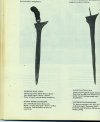I'm glad you brought that up Ivan. I was going to address the straight blade Keris and then the thought got away from me.

And that was the argument I used when asking about the wavy style Keris.
I was told the straight blades were usually longer and thinner than the Flame style blade and from what I've seen that's generally correct.
Only recently have I supposedly learned that the straight blades are considered to be the forerunner of the wavy or 'Flame' style blade.
There's just too many interests, too little time and with some subjects the information can be rare and good proven information rarer still.
As with the kamis and their story, "It came from the clouds over 10,000 feet high and 10,000 years ago."
And sometimes that's the best answer one is ever going to get.

And perhaps sometimes that's the only answer there is.


When it comes to knives the history goes way back beyond even oral records.
I can imagine a convention of sharp edged tool makers way way way way back when...........
"Flint is *the* Absolute Best there is!!!!!"
"No you dumbass, Chert *IS* The Absolute best!!!! There is less edge chipping and it penetrates bones better!!!!"
"Oh you Ignorant Bastids *Obsidian* *IS* the *Absolute* Best* Ever*!!!!!! It does have it's drawbacks, but the surgeons prefer it for trepanning skulls to let out evil spirits found in the heads of some people in our part of the world!!!!!!"
"It's *Absolutely* The Sharpest material in the New Stone Age!!!!"
And then from the pimply faced kid over in the corner with a S*** eatin grin on his face....... "Hay'ull you guys don't know anything about anything!!!!! Have you heard about this new material they're calling *Bronze*? No? Well let me tell you....
It's not quite as sharp as the obsidian, but it doesn't chip even nearly anything like flint does and everyone knows how difficult some flint is to work. And it lasts forever and you can, Get This!!! ***Actually Pry With It!!!!!***"
The worlds very First Sharpened Pry Bar.!!!!!!!






 ).
).











